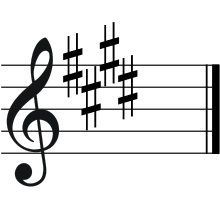E major
E major (or the key of E) is a major scale based on E, with the pitches E, F♯, G♯, A, B, C♯, and D♯. Its key signature has four sharps. Its relative minor is C-sharp minor and its parallel minor is E minor. Its enharmonic equivalent, F-flat major, has eight flats, including the double flat B![]()
 | |
| Relative key | C-sharp minor |
|---|---|
| Parallel key | E minor |
| Dominant key | B major |
| Subdominant | A major |
| Component pitches | |
| E, F♯, G♯, A, B, C♯, D♯ | |
The E major scale is:
Music in E major
Antonio Vivaldi used this key for the "Spring" concerto from The Four Seasons.
Johann Sebastian Bach used E major for a violin concerto, as well as for his third partita for solo violin; the key is especially appropriate for the latter piece because its tonic (E) and subdominant (A) correspond to open strings on the violin, enhancing the tone colour (and ease of playing) of the bariolage in the first movement.
Only two of Joseph Haydn's 104 symphonies are in E major: No. 12 and No. 29.
Beethoven used the key of E major for two of his piano sonatas, Op. 14/1 and Op. 109.
Starting with Ludwig van Beethoven's Piano Concerto No. 3, several works in the key of C minor began to have slow movements in E major, three examples of which are Johannes Brahms' First Symphony and Piano Quartet No. 3, and Sergei Rachmaninoff's Piano Concerto No. 2.
Frédéric Chopin's First Piano Concerto starts in E minor, but the last two movements are in E major. His Étude Op. 10, No. 3, one of his best known works, is in E major. His last Nocturne, Op. 62 No. 2, is also in E major.
Felix Mendelssohn used this key for the finale of his well-known Violin Concerto in E Minor, exploiting these advantages for the solo voice.
Even in the 19th century, symphonies in this key were rare, with Anton Bruckner's Symphony No. 7 being one of very few examples (see list of symphonies in E major). For Bruckner, "the key of E major is frequently associated with music of contemplation."[1]
Alexander Scriabin composed his ambitious first Symphony in E major.
Moritz Moszkowski composed his fast etude (op. 72, no. 1) in E major.
Two symphonies that begin in D minor and end in E major are Havergal Brian's Symphony No. 1 (Gothic) and Carl Nielsen's Symphony No. 4.
More typically, however, some symphonies that begin in E minor switch to E major for the finale, such as Sergei Rachmaninoff's Symphony No. 2, Pyotr Ilyich Tchaikovsky's Symphony No. 5 and Dmitri Shostakovich's Symphony No. 10.
The clock chime of the Westminster Quarters in the clock tower of London's Palace of Westminster are tuned to the key of E major.
In Gioachino Rossini's William Tell Overture, the finale is in E major. Richard Wagner's Tannhäuser Overture is also in E major, expressing the sublime theme by the brass section.
See also
- Key (music)
- Major and minor
- Chord (music)
- Chord names and symbols (popular music)
References
- Philip Barford, Bruckner Symphonies Seattle: University of Washington Press (1978): 52